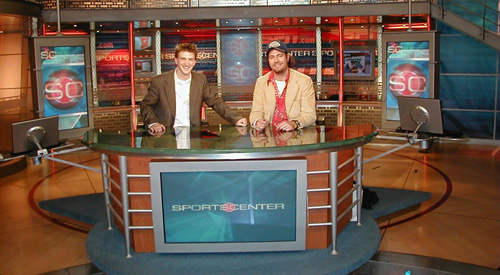
Those Guys Have All The Fun: Inside The World Of ESPN (2011)
Rating: 6/10
Oral histories are a tricky thing: there’s an art to them. It’s not just in the compilation – although talking to the right people certainly helps – but in the questions and answers. In basic terms, it’s not a history if we’ve heard it all before.
One of the best is Tom Shales and James Andrew Miller’s “Live From New York: An Uncensored History of Saturday Night Live.” It’s the definitive look inside Saturday Night Live not only because it explains the backroom dealings at 30 Rock, but also because the people they spoke to didn’t hold back. It’s the only history willing to tell cool stories about Milton Berle, John Belushi and Norm MacDonald.
It’s a shame that Shales/Miller’s new oral history of ESPN isn’t as fun.
The first thing anybody notices about “Those Guys Have All the Fun” is it’s sheer size: it’s over 700 pages in hardcover and even more in paperback. There’s a lot of history here: how ESPN was hatched inside a sweltering car; how the network lucked into an ideal spot to set up satellite dishes; about how the network rode college sports into popularity and eventually dominance; about programming, personnel and purchasing.
The trouble is how few of these stories are new. Sports media junkies interested in a giant history like this have probably heard these stories before: I’d heard some in Will Leitch’s “God Save the Fan” and Mike Freeman’s earlier history of ESPN. And someone who enjoys business histories will have to go through sections of inside baseball talk about journalism and broadcasting.
[php snippet=1]
And it’s not just that the new stories are few and far between. Most of the stories in this book are missing their bite.
The best parts of “Live From New York” had drugs, backstage fighting and Michael O’Donaghue spray-painting on a wall. They were the backroom stories you’d have never heard otherwise unless you had connections. While “Those Guys” has some lurid stories from the early years of the network, it quickly becomes a by-the-books history, heavy on stories that aren’t fresh and isn’t all that enlightening.
When the book deals with sexism at ESPN, it only does so briefly. When it deals with Mike Tirico’s and Tony Kornheiser’s stormy relationship on Monday Night Football, it’s short on actual details. There’s nothing on the level as the Milton Berle story, which Bill Simmons once used to explain why he liked “Live From New York.” Shortly after the book’s release, Simmons expressed some regrets about being so candid. But such candidness is rare in this book: most of it is devoted to a “Rashomon”-like retelling of events, where nobody takes blame and everyone assumes credit. Maybe it’s because people don’t want to poison their careers or they’re bound by contract, but it makes this book seem like an ESPN-approved history of their network.
Still, there’s a lot “Those Guys” gets right. As a straight-up history of the rise of ESPN, it’s an interesting read about how a small cable operation rose to prominence and completely dominated sports media. It clearly explains the moves ESPN made to become successful, from the journalistic backbone of John Walsh to establishing a duel-stream of revenue to their coverage of the 1987 America’s Cup. It explains why ESPN became a behemoth when other sports networks – SportsChannel, Fox Sports Net, etc. – struggled and never established a national foothold. As a business history, it’s a fascinating read.
It’s also an enlightening read for some of the principals. The stories about Chris Berman working in poor conditions – once, after a technical flub, he did a highlight reel from memory, without seeing what was shown on-screen – show not only how important he is to ESPN, but how talented he is as well. There’s a lot more to him than nicknames, yelling and “You’re with me, leather.” His importance to ESPN is hard to overstate, as is his counterpart Bob Ley: the straight-laced, conservative reporter to Berman’s boisterous, affable TV personality.
Likewise, Olbermann comes across as a compelling person, possessing a ton of talent, yet he’s incapable of getting along with anybody for any length of time. His skill set, which goes from his ability to connect with an audience to writing his stories for a broadcast in under half an hour, impresses even his colleagues. Yet the same people breathed a sigh of relief when he left. And the book explains how important the Olbermann and Dan Patrick pairing on SportsCenter was, turning a sports highlight program into popular viewing.
Ultimately, it’s hard to figure out what kind of reader this book is best suited for. Those interested in delving into the history of ESPN have probably already heard most of these stories. Shales and Miller weren’t able to match the same entertaining tone as their last oral history, making it more of a niche novel, and as large as this book is, there’s a lot it doesn’t even get to mentioning: hockey on ESPN; the purchase of TSN; the rise of Page 2 with personalities like Hunter S. Thompson or Ralph Wiley, their book publishing arm, etc.
And nevermind how dated the book’s already become: personalities like Erin Andrews and Michelle Beadle recently left ESPN.
An oral history of ESPN is an interesting idea, but it’s a hard one to pull off. With material spanning over 30 years, it’s hard to condense it all into one volume. And with a closed culture at the ESPN campus, it seems like an uphill battle to get interesting stories on the record.
And that’s what mars this book: despite 700-plus pages and more than 500 interviews, there isn’t a lot here that’s interesting or new. As they write in the introduction, this is the story of ESPN, not it’s history. It’s too bad most sports junkies have already heard this one.
[php snippet=1]

